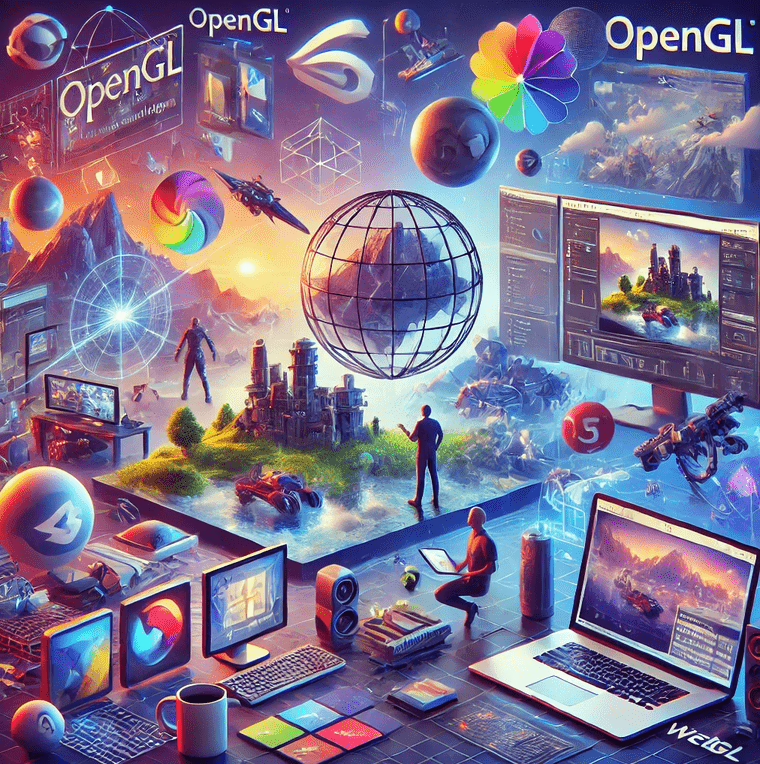In the realm of computer graphics, few technologies have had as profound an impact as OpenGL and WebGL. These graphics APIs (Application Programming Interfaces) have revolutionized the way we render 2D and 3D graphics, providing developers with powerful tools to create visually stunning applications across various platforms. In this article, we delve into the intricacies of OpenGL and WebGL, exploring their features, use cases, and the value they bring to both developers and businesses. Additionally, we highlight how Curate Consulting Services can assist in finding specialized talent to meet your staffing needs in this ever-evolving field.
Understanding OpenGL
Definition: OpenGL (Open Graphics Library) is a cross-platform graphics API that provides a standard specification for rendering 2D and 3D graphics. Originally developed by Silicon Graphics, it is now an open standard maintained by the Khronos Group. OpenGL has become a cornerstone in the world of computer graphics, enabling developers to create high-performance graphics applications that run on various operating systems.
Key Features of OpenGL:
Cross-Platform Compatibility: OpenGL is designed to be platform-independent, allowing developers to write graphics applications that can seamlessly run on different operating systems, including Windows, macOS, and Linux. This cross-platform capability is a significant advantage for developers seeking to reach a broader audience.
Hardware Acceleration: One of the standout features of OpenGL is its ability to leverage the GPU (Graphics Processing Unit) for rendering. This hardware acceleration enables high-performance graphics, making it possible to create visually rich applications with smooth animations and complex visual effects.
Standardized API: OpenGL provides a standardized set of functions and procedures that developers use to interact with the GPU. This standardization simplifies the development process, as developers can rely on a consistent API for tasks like rendering primitives, textures, and shaders, regardless of the underlying hardware.
Extensibility: The API is extensible, allowing hardware vendors to implement additional features through extensions. This extensibility ensures that OpenGL can keep pace with advancements in graphics hardware, providing developers with access to cutting-edge capabilities.
Use Cases of OpenGL:
Computer Graphics: OpenGL is widely used in applications ranging from video games and simulations to scientific visualization. Its ability to render complex 3D graphics in real-time makes it an ideal choice for creating immersive and interactive experiences.
CAD (Computer-Aided Design): Many CAD applications leverage OpenGL for rendering complex 3D models. The precision and performance of OpenGL make it well-suited for applications that require detailed and accurate graphical representations.
Virtual Reality: VR applications often use OpenGL to render immersive 3D environments. The high performance and flexibility of OpenGL allow developers to create realistic and engaging virtual worlds.
Exploring WebGL
Definition: WebGL (Web Graphics Library) is a JavaScript API based on OpenGL ES (Embedded Systems) that enables high-performance 3D graphics rendering within web browsers. It brings GPU-accelerated graphics to the web without requiring additional plugins, making it a powerful tool for creating interactive and visually appealing web applications.
Key Features of WebGL:
Integration with Web Technologies: WebGL is integrated into the HTML5 canvas element, allowing developers to create interactive 3D graphics directly within web pages. This seamless integration with web technologies makes it easy to embed 3D graphics in websites and web applications.
Shader Support: Developers can use GLSL (OpenGL Shading Language) to write custom shaders for advanced graphics effects. This shader support provides fine-grained control over the rendering process, enabling the creation of sophisticated visual effects.
Security: WebGL runs in a secure, sandboxed environment within the browser to prevent malicious actions. This security feature ensures that WebGL applications can run safely without compromising the user’s system.
Use Cases of WebGL:
Web Applications: WebGL is commonly used in web applications that require 3D graphics, such as online games, interactive data visualization, and virtual tours. Its ability to render 3D graphics directly in the browser without plugins enhances the user experience and broadens the reach of these applications.
Educational Content: WebGL is used to create interactive educational content, simulations, and virtual tours on websites. This interactive approach to education can enhance learning by providing students with engaging and visually rich content.
The Role of Curate Consulting Services
In the dynamic field of graphics rendering, finding specialized talent is crucial for businesses looking to leverage technologies like OpenGL and WebGL. Curate Consulting Services excels in helping clients meet their staffing needs by connecting them with highly skilled professionals who possess expertise in these technologies.
Our Expertise:
Talent Acquisition: Curate Consulting Services specializes in identifying and recruiting top-tier talent in the field of graphics rendering. Our extensive network and industry knowledge enable us to find candidates with the precise skills and experience needed for your projects.
Customized Solutions: We understand that every business has unique requirements. Our team works closely with clients to develop customized staffing solutions that align with their specific needs, whether it’s for short-term projects or long-term engagements.
Industry Knowledge: Our deep understanding of the graphics rendering landscape allows us to provide valuable insights and guidance to our clients. We stay abreast of the latest trends and advancements in OpenGL and WebGL, ensuring that we can deliver the most relevant and up-to-date talent solutions.
Conclusion
OpenGL and WebGL have transformed the landscape of graphics rendering, providing developers with powerful tools to create visually compelling and interactive applications across native and web environments. As these technologies continue to evolve, the demand for specialized talent in graphics rendering is on the rise. Curate Consulting Services is committed to helping businesses meet this demand by providing expert staffing solutions tailored to their needs.
Whether you’re developing a cutting-edge video game, creating immersive VR experiences, or building interactive web applications, OpenGL and WebGL offer the capabilities you need to succeed. And with Curate Consulting Services by your side, you can be confident in finding the specialized talent required to bring your vision to life.
If you’re looking to harness the power of OpenGL and WebGL for your next project, or if you need expert assistance in finding the right talent, contact Curate Consulting Services today. Together, we can achieve remarkable results and push the boundaries of what’s possible in graphics rendering.



